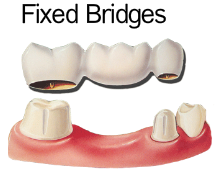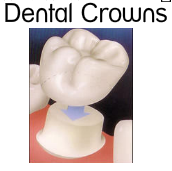Restorative Dentistry

Each tooth helps keep the dental arches in their proper positions and balance. When one or more teeth are missing, the remaining teeth frequently drift out of position and place unnatural stress on tissues in your mouth. This can lead to dental caries (tooth decay) and periodontal (gum) disease, which could lead to more tooth loss. Crowns and fixed bridges (fixed partial dentures) can restore your teeth to their normal function. These restorations prevent the collapse of the dental arch, and improve chewing ability, speech, and appearance.
Fixed Bridge Design:
(fixed partial denture) replaces one or more missing natural teeth. It is cemented into place and is firmly attached to the natural teeth next to the space. These teeth are called the abutment teeth. Crowns are placed on the abutment teeth to provide support for the fixed bridge. The pontic, or the artificial tooth, is the part of the fixed bridge that replaces the lost tooth. The pontic is fused to the crowns on abutment teeth.

Crowns:
is a restoration that covers, or caps, a tooth to restore the normal shape and size. It gives strength to a tooth, and protects a tooth from fracture. The location of the teeth, condition of your oral health, and other factors determine the type of material that will be used for the crown.Why replace outdated Restorations?
There are many reasons for replacing restorations. In fact, most dental problems may not be evident to patients. When you consider the daily stresses exerted on your teeth, it is not surprising that restorations eventually wear out and sometimes need to be replaced. Some patients believe the old adage: "if it doesn't hurt, don't fix it." If left untreated, some dental problems can lead to more expensive dental procedures and eventual tooth loss.
